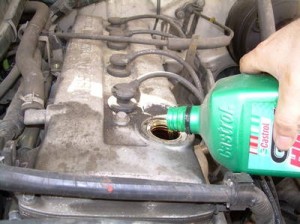Slick advice: How to check your oil
To say engine oil is to a vehicle what blood is to the human body wouldn’t be an overstatement.
Without oil keeping an engine at proper temperature and well-lubricated, the moving parts would grind against one another, causing the engine to freeze up and stop working and, literally, have a meltdown. Dirty oil contributes to sludge in the engine and won’t lubricate the parts as efficiently as clean, fresh oil.
That’s why it’s vitally important to make sure the motor oil is at the proper level and clean.
Despite all this disaster chatter, checking your oil is one of the easiest and fastest auto-related tasks to perform.
You’ll obtain the most reliable reading by allowing your automobile to cool down for roughly one hour. This allows the oil to drain out of the engine and back into the vehicle’s oil pan. Otherwise, a false low-oil reading might occur.

Checking the oil is one of the easiest—and perhaps most vitally important—automotive tasks drivers can perform.
Now, proceed through the following steps.
Park your vehicle on a flat, level surface and secure it by engaging the parking brake. Then, open the hood.
Find the oil dipstick. To determine the dipstick’s location, you might need to view your owner’s manual or the decal under the hood. However, the dipstick on today’s cars and trucks typically has a yellow or white loop handle attached to it and may even have “engine” printed on it.
Hook one finger through this loop and pull the dipstick all the way out of its lodging. Wipe the dipstick clean with either a rag or paper towel, making sure to remove all oil. Reinsert the dipstick into the opening and push it all the way back in, making sure not to bend it in the process. Pull the dipstick out all the way once again and look at the oil level indicated on the dipstick. Note that the dipstick contains markings (dimpled, etched or notched) showing the proper oil-level range.
If the level is too low, oil must be added to avoid engine damage. It’s best to use a funnel when adding oil. Simply locate the oil filler cap, which is a large screw cap typically located in the middle of the engine and often marked “oil.” Fill to the appropriate level and screw the cap back on. Caution: Only add one quart at a time. Too much oil isn’t a good thing. Also, make sure you use the correct oil grade (5W-30 or 10W-30, for example), which will be specified in your owner’s manual.

What a daredevil! Adding oil without a funnel is best reserved for steady-handed pros or people with plenty of old rags.
When checking oil level, it’s also a good idea to examine the quality of the oil. Clean engine oil is golden in appearance; dirty oil might be black or brown. Dark oil doesn’t mean it’s not doing its job, but regard it as a signal to check your maintenance records to determine when your vehicle’s last oil change occurred. Adhere to the recommended change interval (mileage and time) more than simply the oil color.
Milky or foamy oil is a red flag that it might have become contaminated with coolant. In this case, immediately bring your vehicle into Hong Kong Auto Service to determine the cause of the problem.
Finally, get in the habit of occasionally glancing at the surface (driveway, garage floor, street) under where you typically park your car. Oil leaks aren’t good hiders and will often show themselves on these surfaces.
